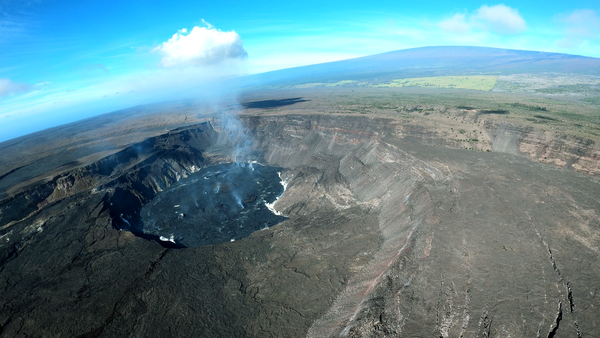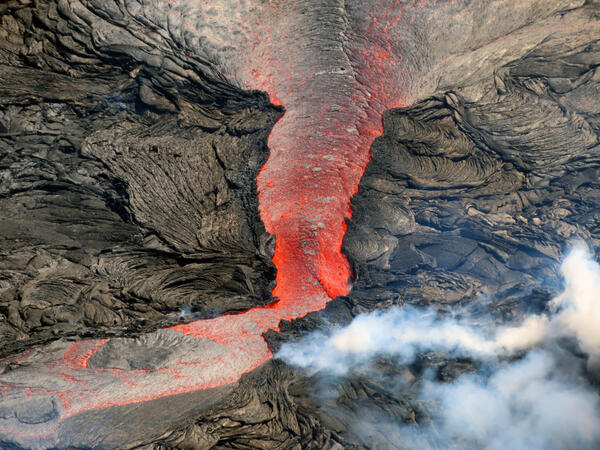What is a seismic survey? This video gives a very brief overview of the what goes into conducting a seismic survey in an urban area. The survey depicted in this video was done in San Carlos, California.
Videos
Explore a diverse collection of engaging videos showcasing the latest research, discoveries, and educational content from the U.S. Geological Survey. Dive into the fascinating world of geology, hydrology, ecology, and natural hazards as we bring science to life. Stay informed and inspired by our visual storytelling that highlights the vital work of USGS scientists and their impact on the planet.
Subscribe to us
What is a seismic survey? This video gives a very brief overview of the what goes into conducting a seismic survey in an urban area. The survey depicted in this video was done in San Carlos, California.
 Color thumbnail for USGS EROS Center Image of the Week - Flooding in Tweed Heads Australia
Color thumbnail for USGS EROS Center Image of the Week - Flooding in Tweed Heads Australia
Image of the Week - Flooding in Tweed Heads, Australia
Image of the Week - Flooding in Tweed Heads, AustraliaEurope's Copernicus Sentinel-2 satellites revealed flooding at Tweed Heads, New South Wales. Heavy rain that persisted for days in late February 2022 caused widespread flooding on Australia's east coast.
Image of the Week - Flooding in Tweed Heads, Australia
Image of the Week - Flooding in Tweed Heads, AustraliaEurope's Copernicus Sentinel-2 satellites revealed flooding at Tweed Heads, New South Wales. Heavy rain that persisted for days in late February 2022 caused widespread flooding on Australia's east coast.
 Color map of eruption at summit of volcano
Color map of eruption at summit of volcano
March 17, 2022 — Kīlauea summit eruption overflight video
March 17, 2022 — Kīlauea summit eruption overflight videoA routine helicopter overflight on March 17, 2022, provided airborne views of the summit eruption in Halema‘uma‘u crater, at the summit of Kīlauea. At the start of the video, the helicopter flies over the edge of the large collapse depression formed during the 2018 eruption.
March 17, 2022 — Kīlauea summit eruption overflight video
March 17, 2022 — Kīlauea summit eruption overflight videoA routine helicopter overflight on March 17, 2022, provided airborne views of the summit eruption in Halema‘uma‘u crater, at the summit of Kīlauea. At the start of the video, the helicopter flies over the edge of the large collapse depression formed during the 2018 eruption.
 Helicopter towing large hoop over snow covered ground, technician for scale
Helicopter towing large hoop over snow covered ground, technician for scale
Southern Wisconsin Airborne Electromagnetic Survey 2022
Southern Wisconsin Airborne Electromagnetic Survey 2022Low-flying helicopter with geophysical equipment loop deployed below it via slingload. In March 2022, a helicopter carried an airborne electromagnetic induction sensor over parts of southeast and southwest Wisconsin as part of a USGS study to map the aquifers in the region.
Southern Wisconsin Airborne Electromagnetic Survey 2022
Southern Wisconsin Airborne Electromagnetic Survey 2022Low-flying helicopter with geophysical equipment loop deployed below it via slingload. In March 2022, a helicopter carried an airborne electromagnetic induction sensor over parts of southeast and southwest Wisconsin as part of a USGS study to map the aquifers in the region.
A morning overflight of Kīlauea summit on March 2, 2022, provided aerial views of the eruption within Halema‘uma‘u. Lava erupts from the west vent area and pours into the active lava lake area.
A morning overflight of Kīlauea summit on March 2, 2022, provided aerial views of the eruption within Halema‘uma‘u. Lava erupts from the west vent area and pours into the active lava lake area.
Monthly update of activity at Yellowstone Volcano for March 2022
Monthly update of activity at Yellowstone Volcano for March 2022Happy 150th birthday to Yellowstone National Park! The Park is truly a wonderland, and a place of continuous inspiration and learning. Listen, as Yellowstone Volcano Observatory Scientist-in-Charge Mike Poland recounts some of its unique history and provides an update of recent earthquakes, ground deformation, and geyser activity.
Monthly update of activity at Yellowstone Volcano for March 2022
Monthly update of activity at Yellowstone Volcano for March 2022Happy 150th birthday to Yellowstone National Park! The Park is truly a wonderland, and a place of continuous inspiration and learning. Listen, as Yellowstone Volcano Observatory Scientist-in-Charge Mike Poland recounts some of its unique history and provides an update of recent earthquakes, ground deformation, and geyser activity.
 Polar bear on ice with text reading 2022 Polar Bear Research Masterplan
Polar bear on ice with text reading 2022 Polar Bear Research Masterplan
Scientists continue to study how a warming Arctic will affect polar bear populations. The new 2022 Polar Bear Research Council Masterplan identifies how polar bears in zoos can help fill knowledge gaps that benefit wild populations.
Scientists continue to study how a warming Arctic will affect polar bear populations. The new 2022 Polar Bear Research Council Masterplan identifies how polar bears in zoos can help fill knowledge gaps that benefit wild populations.
 Do droughts affect groundwater quality?
Do droughts affect groundwater quality?
PubTalk-02/2022 - Do Droughts Affect Groundwater Quality? A California Story
PubTalk-02/2022 - Do Droughts Affect Groundwater Quality? A California StoryDo Droughts Affect Groundwater Quality? A California Story
By Zeno Levy, USGS Research Geologist
PubTalk-02/2022 - Do Droughts Affect Groundwater Quality? A California Story
PubTalk-02/2022 - Do Droughts Affect Groundwater Quality? A California StoryDo Droughts Affect Groundwater Quality? A California Story
By Zeno Levy, USGS Research Geologist
 Color photograph of lava flow
Color photograph of lava flow
February 17, 2022 — Typical activity at the west vent in Halema‘uma‘u, Kīlauea
February 17, 2022 — Typical activity at the west vent in Halema‘uma‘u, KīlaueaThis video clip shows typical activity at the west vent, in Halema‘uma‘u crater at the summit of Kīlauea. Lava upwells in a small pond and then flows into the main lake via a narrow channel.
February 17, 2022 — Typical activity at the west vent in Halema‘uma‘u, Kīlauea
February 17, 2022 — Typical activity at the west vent in Halema‘uma‘u, KīlaueaThis video clip shows typical activity at the west vent, in Halema‘uma‘u crater at the summit of Kīlauea. Lava upwells in a small pond and then flows into the main lake via a narrow channel.
 color thumbnail of USGS EROS Image of the Week - Olympic Skiing in Bejing
color thumbnail of USGS EROS Image of the Week - Olympic Skiing in Bejing
A satellite image of the mountains that will host Olympic skiing events should display a snowy landscape, right? But the National Alpine Ski Centre and Sliding Centre 45 miles northwest of Beijing, China doesn't get much snowfall. Instead, the steep slopes are lined with manmade snow.
A satellite image of the mountains that will host Olympic skiing events should display a snowy landscape, right? But the National Alpine Ski Centre and Sliding Centre 45 miles northwest of Beijing, China doesn't get much snowfall. Instead, the steep slopes are lined with manmade snow.
February 7– 10, 2022 – Kīlauea summit eruption thermal timelapse video
February 7– 10, 2022 – Kīlauea summit eruption thermal timelapse videoEruptive activity at the summit of Kīlauea, within Halema‘uma‘u crater, has recently been characterized by the eruption waxing and waning over timescales of days. This video, captured from February 7–10, 2022, by the F1cam, a thermal camera located on the west rim of the caldera and looking east, shows the eruption pass through a pause cycle.
February 7– 10, 2022 – Kīlauea summit eruption thermal timelapse video
February 7– 10, 2022 – Kīlauea summit eruption thermal timelapse videoEruptive activity at the summit of Kīlauea, within Halema‘uma‘u crater, has recently been characterized by the eruption waxing and waning over timescales of days. This video, captured from February 7–10, 2022, by the F1cam, a thermal camera located on the west rim of the caldera and looking east, shows the eruption pass through a pause cycle.
This video, taken on February 10, 2022, shows lava upwelling at the western vent, in Halema‘uma‘u crater at the summit of Kīlauea, before flowing into the lava lake to the east via a narrow channel.
This video, taken on February 10, 2022, shows lava upwelling at the western vent, in Halema‘uma‘u crater at the summit of Kīlauea, before flowing into the lava lake to the east via a narrow channel.
 USGS symbol and title text on image of coastal forest landscape and bay
USGS symbol and title text on image of coastal forest landscape and bay
Nitrogen in the Chesapeake Bay Watershed: A Century of Change
Nitrogen in the Chesapeake Bay Watershed: A Century of ChangeNarrated presentation that provides a unique, long-term perspective (1950-2050) of the major drivers of nitrogen change up to the present, and forecasts how they may affect nitrogen into the future for the Chesapeake Bay watershed. Information is based off of U.S. Geological Survey Circular 1486.
Nitrogen in the Chesapeake Bay Watershed: A Century of Change
Nitrogen in the Chesapeake Bay Watershed: A Century of ChangeNarrated presentation that provides a unique, long-term perspective (1950-2050) of the major drivers of nitrogen change up to the present, and forecasts how they may affect nitrogen into the future for the Chesapeake Bay watershed. Information is based off of U.S. Geological Survey Circular 1486.
 color thumbnail for USGS EROS Image of the Week - Landsat's 10 Millionth Scene
color thumbnail for USGS EROS Image of the Week - Landsat's 10 Millionth Scene
Landsat 7 had the honor of acquiring the satellite program’s 10 millionth scene in November 2021.
The scene captures changes to the Dead Sea, located in Southwest Asia. The Dead Sea is mainly fed by the Jordan River, which enters from the north. However, the water level of the Dead Sea has been falling due to irrigation projects and water use upstream.
Landsat 7 had the honor of acquiring the satellite program’s 10 millionth scene in November 2021.
The scene captures changes to the Dead Sea, located in Southwest Asia. The Dead Sea is mainly fed by the Jordan River, which enters from the north. However, the water level of the Dead Sea has been falling due to irrigation projects and water use upstream.
The Arctic region is warming faster than anywhere else in the nation. Understanding the rates and causes of coastal change in Alaska is needed to identify and mitigate hazards that might affect people and animals that call Alaska home.
The Arctic region is warming faster than anywhere else in the nation. Understanding the rates and causes of coastal change in Alaska is needed to identify and mitigate hazards that might affect people and animals that call Alaska home.
February 4, 2022 — Kīlauea summit eruption observations
February 4, 2022 — Kīlauea summit eruption observationsA Kīlauea summit eruption monitoring shift on February 4, 2022, provided views of the eruption within Halema‘ma‘u crater. Lava flows from a pond north of the west vent into the lava lake, which exhibits areas of spattering.
February 4, 2022 — Kīlauea summit eruption observations
February 4, 2022 — Kīlauea summit eruption observationsA Kīlauea summit eruption monitoring shift on February 4, 2022, provided views of the eruption within Halema‘ma‘u crater. Lava flows from a pond north of the west vent into the lava lake, which exhibits areas of spattering.
 The Buffalo Soldiers of the 25th Infantry Regiment Bicycle Corps walk their cycles up Minerva Terrace, Mammoth Hot Springs, Yellowstone National Park
The Buffalo Soldiers of the 25th Infantry Regiment Bicycle Corps walk their cycles up Minerva Terrace, Mammoth Hot Springs, Yellowstone National Park
Monthly update of activity at Yellowstone Volcano for Jan 2022
Monthly update of activity at Yellowstone Volcano for Jan 2022This monthly update from the Yellowstone Volcano Observatory begins with a story.
Monthly update of activity at Yellowstone Volcano for Jan 2022
Monthly update of activity at Yellowstone Volcano for Jan 2022This monthly update from the Yellowstone Volcano Observatory begins with a story.
Recent activity at Kīlauea summit - February 1, 2022
Recent activity at Kīlauea summit - February 1, 2022These video clips show recent activity at the lava lake in Halema‘uma‘u crater, at the summit of Kīlauea. Lava upwelling at the western vent flows into the lake, where bubbling is commonly present. In the eastern portion of the crater, a steep spatter cone has produced vigorous spattering and small lava flows.
Recent activity at Kīlauea summit - February 1, 2022
Recent activity at Kīlauea summit - February 1, 2022These video clips show recent activity at the lava lake in Halema‘uma‘u crater, at the summit of Kīlauea. Lava upwelling at the western vent flows into the lake, where bubbling is commonly present. In the eastern portion of the crater, a steep spatter cone has produced vigorous spattering and small lava flows.
 Deformation and geochemical anomalies near South Sister, Oregon
Deformation and geochemical anomalies near South Sister, Oregon
Tracking uplift near Three Sisters volcanoes, using semi-permanent GPS instruments
Tracking uplift near Three Sisters volcanoes, using semi-permanent GPS instrumentsUSGS geologist Dan Dzurisin is near Sisters, in Central Oregon, to set up portable GPS monitoring equipment to track something that's been going on for 25 years and still goes on today. It’s uplift, a subtle rise in the ground’s surface, in an area west of South Sister volcano.
Tracking uplift near Three Sisters volcanoes, using semi-permanent GPS instruments
Tracking uplift near Three Sisters volcanoes, using semi-permanent GPS instrumentsUSGS geologist Dan Dzurisin is near Sisters, in Central Oregon, to set up portable GPS monitoring equipment to track something that's been going on for 25 years and still goes on today. It’s uplift, a subtle rise in the ground’s surface, in an area west of South Sister volcano.
On January 28, the USGS-Hawaiian Volcano Observatory conducted Unoccupied Aerial Systems (UAS) missions at the summit of Kīlauea, within Hawai‘i Volcanoes National Park.
On January 28, the USGS-Hawaiian Volcano Observatory conducted Unoccupied Aerial Systems (UAS) missions at the summit of Kīlauea, within Hawai‘i Volcanoes National Park.
HVO field crews participated in an overflight and ground work at the summit of Kīlauea on January 27. This video compilation contains footage taken from the air and ground.
HVO field crews participated in an overflight and ground work at the summit of Kīlauea on January 27. This video compilation contains footage taken from the air and ground.












